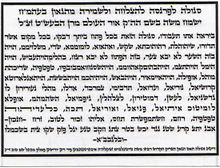- Moshe Teitelbaum (Ujhel)
-
Not to be confused with Moshe Teitelbaum (Satmar).
Rabbi Moshe Teitelbaum (1759 - 16 July 1841) (Hebrew: משה טייטלבוים), also known as the Yismach Moshe, was the Rebbe of Ujhely in Hungary. According to Löw, he signed his name "Tamar", this being the equivalent of Teitelbaum, which is the Yiddish for "palm-tree" (compare German "Dattelbaum"). An adherent of the Polish Hasidic Rebbe, the Chozeh of Lublin, Rabbi Teitelbaum was instrumental in bringing Hasidic Judaism to Hungary. Though initially opposed to Hassidism, after his son-in-law introduced him to the Chozeh of Lublin, he soon became an adherent to Hassidism.[citation needed] *(Dezsö Schön, 1997)
Teitelbaum first served as a rabbi in Przemyśl, and later in Sátoralja-Ujhely, where he was called in 1808.[1] In Ujhely he founded a Hassidic congregation which was independent of the Galician leaders. In 1822 Teitelbaum was suspected of having supplied amulets to certain Jewish culprits who had been cast into prison for libel, in order to assist them in escaping. When called upon to vindicate himself he declared that the amulets in question served only as substitutes for the mezuzah and that their only purpose was to protect their bearers against demons. Teitelbaum enjoyed an enviable reputation, with even Rabbi Moses Sofer paying him homage.
Contents
Works
Teitelbaum authored three main works, Heishiv Moshe ("Moses Responded", a collection of responsa), Tefillah le-Mosheh, (a commentary on Psalms), and Yismach Moshe ("Moses Rejoiced", 1849; 2d ed. 1898, containing homilies on the Torah), and he is commonly referred to by the title of the latter. He originally wrote a significant portion of his commentary on Psalms on the backs of personal notes handed to him by petitioners seeking his aid and blessing. These notes were transmitted via a succession of prominent hasidic rabbis, until finally being edited and published for the first time n Krakow in 1880.[2]
His descendants became leaders of the communities of Sighet and Satmar known as Satmar Hasidim. He was said to have identified his three prior gilgulim (incarnations in Judaism), saying that in his first gilgul he had been a sheep in Yaakov Avinu's flock,[3] in his second incarnation he lived in the time of Moses, and in his third incarnation he lived during the time of the destruction of the First Temple. In humility, he did not disclose the nature of the third incarnation, but his followers asked another Rebbe, who identified it as the Biblical Prophet Jeremiah. Regarding the first gilgul, he taught his followers the song, he said, that he recalled Jacob would sing as he tended the sheep.
He was once learning the story of Korach in the Torah with his young grandson the Yetev Lev and the Yetev Lev made a comment showing that he didn't think much of Korach, who rebelled against Moses. At that point the Yismach Moshe admonished him saying that we have no understanding of the greatness of Korach. In fact, added the Yismach Moshe, he himself was a gilgul from that "Dor HaMidbar" (generation of the desert) and had not been sure whom to follow, since this seemed to be a valid argument between the two greatest men of the generation. His grandson then asked him, "If so what did you do and how did you save yourself?" The Yismach Moshe said "Not wanting to be part of the machlokes (argument) I ran into my tent and closed the entrance tightly. I refused to come out until it was all over."[citation needed]
His followers would teach of his previous identification with Jeremiah, and how this affected his present life. In his later days he yearned so much for the coming of the Jewish Messiah and the rebuilding of the Temple, that he wore his Shabbat clothing the entire week, anticipating the Messiah's arrival. He died on July 17, 1841.
See also
References
- ^ 'Codex Judaica', M.Kantor p.259
- ^ Cited in introduction to Tefillah le-Moshe, Teitelbaum, Monroe, NY 2010 ed.
- ^ The Biblical Patriach Jacob fathered the 12 Tribes of the Jewish people. Kabbalah teaches that his flock of sheep comprised the future root souls of Israel. The identification by Moshe Teitelbaum of this first incarnation, would accordingly be novel for his recollection of it
Jewish Encyclopedia bibliography
This article incorporates text from the 1901–1906 Jewish Encyclopedia, a publication now in the public domain.
- Aaron Walden, Shem ha-Gedolim he-Ḥadash, p. 101;
- Löw, Gesammelte Schriften, ii.76, 84, 91.
- Dezsö Schön, Istenkeresök a Kárpátok alatt (God-seekers under the Carpathians) , 97. Budapest, Múlt és Jövö
Categories:- 18th-century rabbis
- 19th-century rabbis
- Rebbes of Satmar
- Jews from Galicia (Eastern Europe)
- Hungarian Orthodox rabbis
- Hasidic rabbis in Europe
- Hungarian people of Polish descent
- 1759 births
- 1841 deaths
Wikimedia Foundation. 2010.

